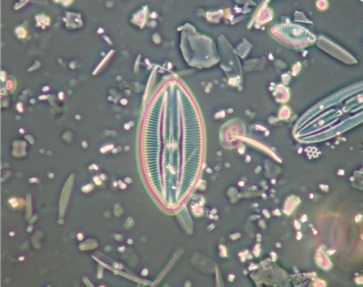References:
Diatoms are minute but extremely important units of aquatic ecosystems. Their role and significance demonstrate the enormous value contained in their microscopic size. Their conservation and study are vital for the stability and health of aquatic ecosystems.

About Diatoms:
- They are unicellular and extremely minute algae. However, their role is vital.
- They are found in abundance in oceans and other water bodies and contribute significantly to the oxygen production of the earth.
- They are found in freshwater, saltwater, flowing water, stagnant water, rocks, sand, damp places, submerged stones, etc.
- Due to their diversity and number, they have been classified as a separate kingdom called the Protista Kingdom.
- Kingdom Protista includes about 64,000 to 100,000 species of diatoms divided into 1,200 genera.
- Studies have shown that diatoms are functionally unicellular but some diatoms produce fibres. Some diatoms have tubes like tree branches, formed by division of cells.
- The cell wall of diatoms is divided into two parts: epitheca and hypotheca
- Classification: Diatoms can be classified into two major types:
- Centric diatoms: These are spherical and form plankton in water.
- Pennate diatoms: These are not spherical and have slits.\
- Diatoms with slits are called raphides and those without slits are called araphides.
- Harmful diatoms: Some diatom species produce toxins that can cause fish kills. These toxins increase the acidity of water, which leads to the death of other aquatic life. Their excessive growth can block rivers and streams, which has a negative impact on the ecosystem.
Multifunctional roles of diatoms:
- Key component of the food chain: They produce energy by photosynthesis in water which makes them a key component of the aquatic food chain. These algae are not only a source of food for small aquatic animals but also an important part of the primary diet for larger aquatic organisms.
- As oxygen producers: They contribute significantly to the abundant oxygen production in oceans and other water bodies. Diatoms produce about 20-25% of global oxygen production.
- As CO2 absorbers: These algae are important absorbers of CO2 which contribute to reducing the adverse effects of climate change by absorbing carbon at the global level.
- As an environmental indicator: Diatoms are important indicators of environmental change. Their distribution and life cycle can also be indicators of water quality and ecosystem status. They also provide information related to water salinity, pH, nutrient status, climate change and sea level changes and other ecological changes.
- Dual role: Diatoms play a dual role in the environment. They are producers as well as feed on other small organisms.
- Commercial use: Fossils of diatoms are used in obtaining silica, manufacturing pesticides, filters, metal polishing, catalysts, paper industry and plastic industry etc.
- Forensic use: In forensic science, diatoms provide important evidence during the investigation of water deaths. When a person drowns in water, the diatoms present in the water enter the dead body. These diatoms are found during the examination of the body which help in identifying the cause of death.



